Investigating Hippotherapy for Children with Cerebral Palsy: Proposal
VerifiedAdded on 2022/09/02
|18
|4632
|36
Project
AI Summary
This research proposal aims to investigate the experiences of children with cerebral palsy (CP) undergoing hippotherapy, focusing on their functional capabilities from the perspective of the children and their caregivers. The study will employ a qualitative research design using narrative methodology, collecting data through audio logs and reflective diaries. The research will use purposive sampling to select participants aged 5 to 15 years with CP who have not previously undergone hippotherapy. The proposal includes a thorough literature review examining the existing research on hippotherapy's impact on CP, highlighting the gaps in understanding the children's lived experiences. The methodology section details the data collection and analysis methods, emphasizing ethical considerations. The study seeks to understand the emotional and functional outcomes of hippotherapy, potentially informing evidence-based practices. The research will begin by gathering baseline data on activities of daily living (ADLs) before the children begin hippotherapy, and then continue to gather data during and after the therapy. This research aims to contribute to a better understanding of the impact of hippotherapy on children with CP.
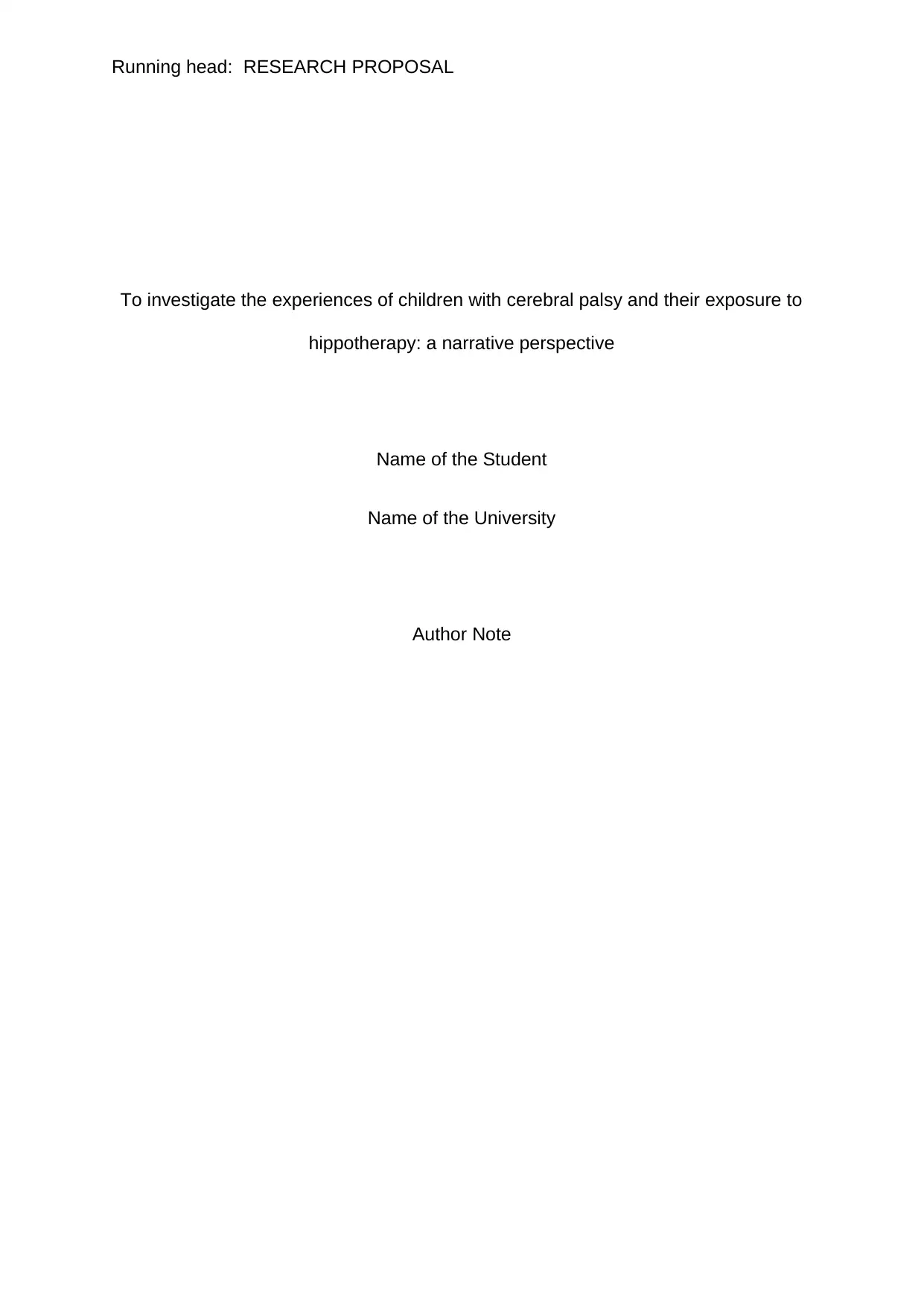
Running head: RESEARCH PROPOSAL
To investigate the experiences of children with cerebral palsy and their exposure to
hippotherapy: a narrative perspective
Name of the Student
Name of the University
Author Note
To investigate the experiences of children with cerebral palsy and their exposure to
hippotherapy: a narrative perspective
Name of the Student
Name of the University
Author Note
Paraphrase This Document
Need a fresh take? Get an instant paraphrase of this document with our AI Paraphraser
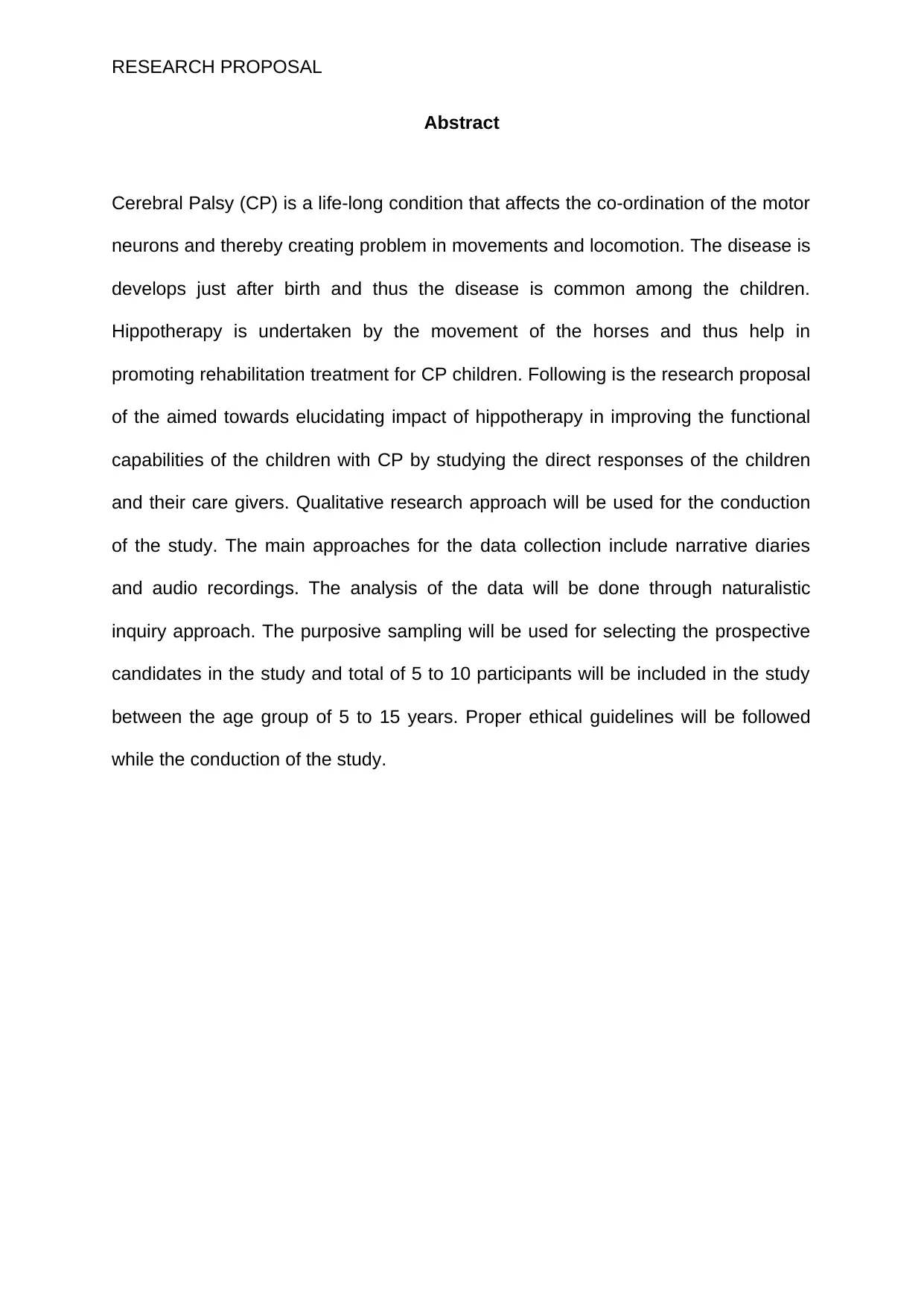
RESEARCH PROPOSAL
Abstract
Cerebral Palsy (CP) is a life-long condition that affects the co-ordination of the motor
neurons and thereby creating problem in movements and locomotion. The disease is
develops just after birth and thus the disease is common among the children.
Hippotherapy is undertaken by the movement of the horses and thus help in
promoting rehabilitation treatment for CP children. Following is the research proposal
of the aimed towards elucidating impact of hippotherapy in improving the functional
capabilities of the children with CP by studying the direct responses of the children
and their care givers. Qualitative research approach will be used for the conduction
of the study. The main approaches for the data collection include narrative diaries
and audio recordings. The analysis of the data will be done through naturalistic
inquiry approach. The purposive sampling will be used for selecting the prospective
candidates in the study and total of 5 to 10 participants will be included in the study
between the age group of 5 to 15 years. Proper ethical guidelines will be followed
while the conduction of the study.
Abstract
Cerebral Palsy (CP) is a life-long condition that affects the co-ordination of the motor
neurons and thereby creating problem in movements and locomotion. The disease is
develops just after birth and thus the disease is common among the children.
Hippotherapy is undertaken by the movement of the horses and thus help in
promoting rehabilitation treatment for CP children. Following is the research proposal
of the aimed towards elucidating impact of hippotherapy in improving the functional
capabilities of the children with CP by studying the direct responses of the children
and their care givers. Qualitative research approach will be used for the conduction
of the study. The main approaches for the data collection include narrative diaries
and audio recordings. The analysis of the data will be done through naturalistic
inquiry approach. The purposive sampling will be used for selecting the prospective
candidates in the study and total of 5 to 10 participants will be included in the study
between the age group of 5 to 15 years. Proper ethical guidelines will be followed
while the conduction of the study.
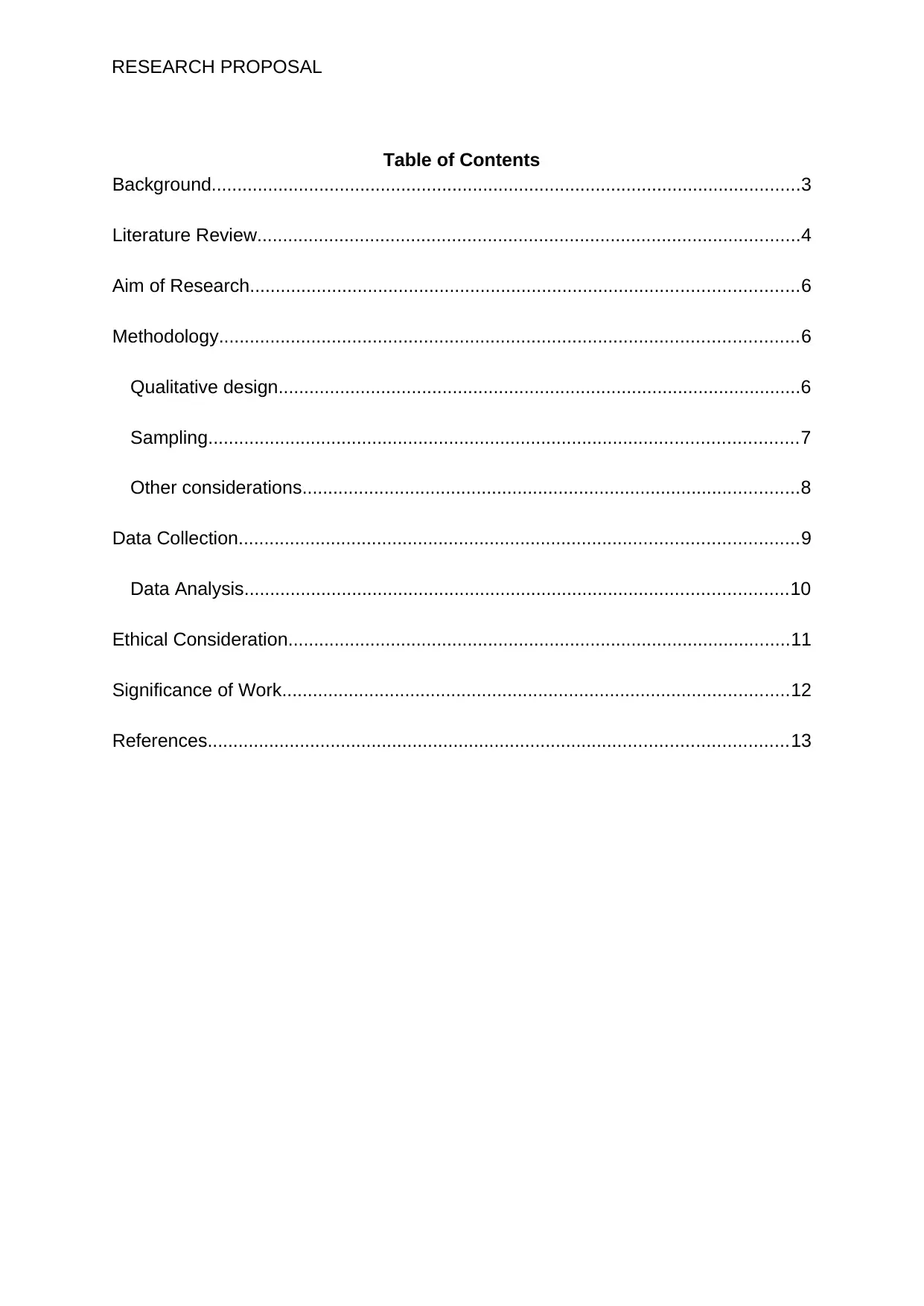
RESEARCH PROPOSAL
Table of Contents
Background...................................................................................................................3
Literature Review..........................................................................................................4
Aim of Research...........................................................................................................6
Methodology.................................................................................................................6
Qualitative design......................................................................................................6
Sampling...................................................................................................................7
Other considerations.................................................................................................8
Data Collection.............................................................................................................9
Data Analysis..........................................................................................................10
Ethical Consideration..................................................................................................11
Significance of Work...................................................................................................12
References.................................................................................................................13
Table of Contents
Background...................................................................................................................3
Literature Review..........................................................................................................4
Aim of Research...........................................................................................................6
Methodology.................................................................................................................6
Qualitative design......................................................................................................6
Sampling...................................................................................................................7
Other considerations.................................................................................................8
Data Collection.............................................................................................................9
Data Analysis..........................................................................................................10
Ethical Consideration..................................................................................................11
Significance of Work...................................................................................................12
References.................................................................................................................13
⊘ This is a preview!⊘
Do you want full access?
Subscribe today to unlock all pages.

Trusted by 1+ million students worldwide
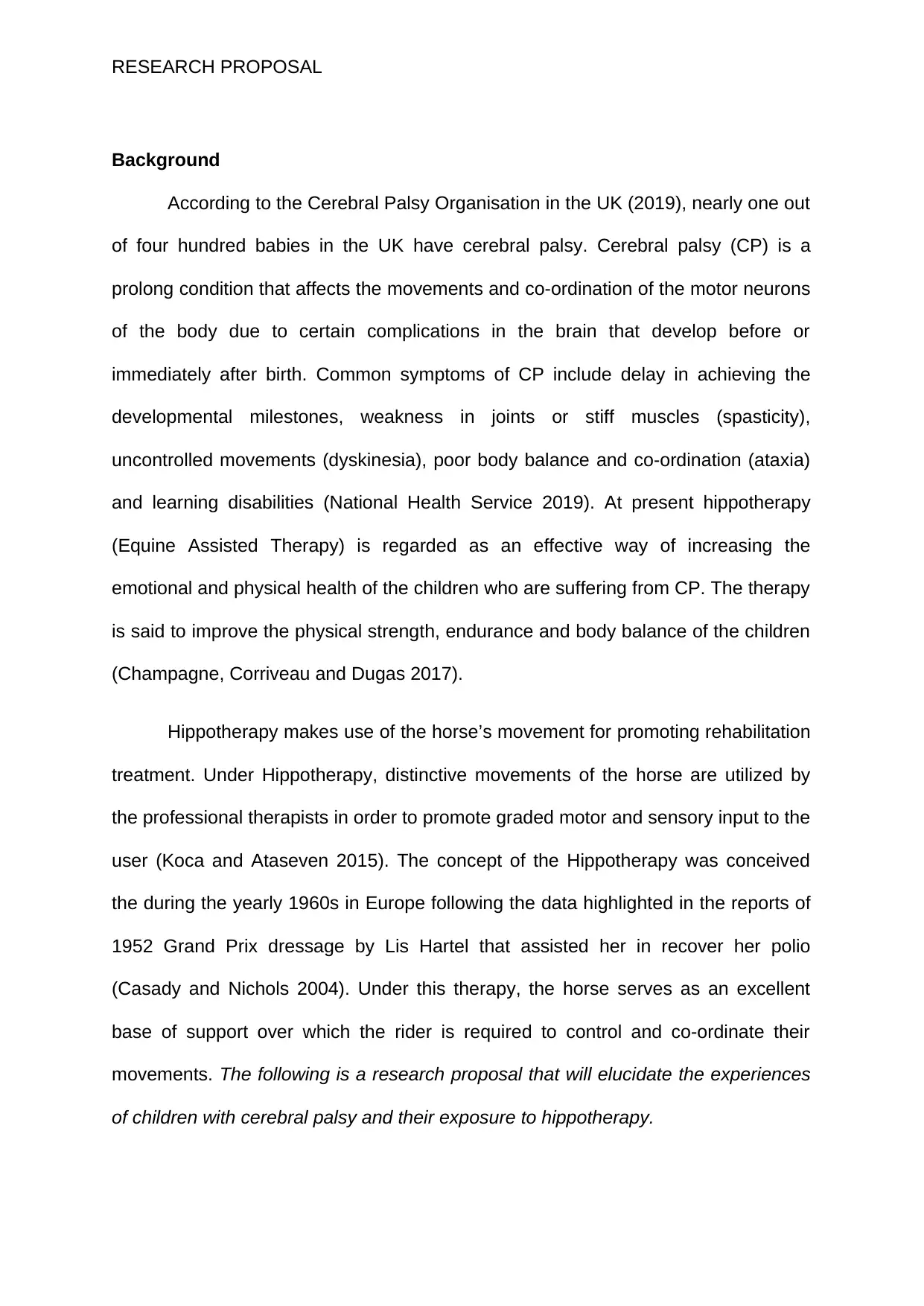
RESEARCH PROPOSAL
Background
According to the Cerebral Palsy Organisation in the UK (2019), nearly one out
of four hundred babies in the UK have cerebral palsy. Cerebral palsy (CP) is a
prolong condition that affects the movements and co-ordination of the motor neurons
of the body due to certain complications in the brain that develop before or
immediately after birth. Common symptoms of CP include delay in achieving the
developmental milestones, weakness in joints or stiff muscles (spasticity),
uncontrolled movements (dyskinesia), poor body balance and co-ordination (ataxia)
and learning disabilities (National Health Service 2019). At present hippotherapy
(Equine Assisted Therapy) is regarded as an effective way of increasing the
emotional and physical health of the children who are suffering from CP. The therapy
is said to improve the physical strength, endurance and body balance of the children
(Champagne, Corriveau and Dugas 2017).
Hippotherapy makes use of the horse’s movement for promoting rehabilitation
treatment. Under Hippotherapy, distinctive movements of the horse are utilized by
the professional therapists in order to promote graded motor and sensory input to the
user (Koca and Ataseven 2015). The concept of the Hippotherapy was conceived
the during the yearly 1960s in Europe following the data highlighted in the reports of
1952 Grand Prix dressage by Lis Hartel that assisted her in recover her polio
(Casady and Nichols 2004). Under this therapy, the horse serves as an excellent
base of support over which the rider is required to control and co-ordinate their
movements. The following is a research proposal that will elucidate the experiences
of children with cerebral palsy and their exposure to hippotherapy.
Background
According to the Cerebral Palsy Organisation in the UK (2019), nearly one out
of four hundred babies in the UK have cerebral palsy. Cerebral palsy (CP) is a
prolong condition that affects the movements and co-ordination of the motor neurons
of the body due to certain complications in the brain that develop before or
immediately after birth. Common symptoms of CP include delay in achieving the
developmental milestones, weakness in joints or stiff muscles (spasticity),
uncontrolled movements (dyskinesia), poor body balance and co-ordination (ataxia)
and learning disabilities (National Health Service 2019). At present hippotherapy
(Equine Assisted Therapy) is regarded as an effective way of increasing the
emotional and physical health of the children who are suffering from CP. The therapy
is said to improve the physical strength, endurance and body balance of the children
(Champagne, Corriveau and Dugas 2017).
Hippotherapy makes use of the horse’s movement for promoting rehabilitation
treatment. Under Hippotherapy, distinctive movements of the horse are utilized by
the professional therapists in order to promote graded motor and sensory input to the
user (Koca and Ataseven 2015). The concept of the Hippotherapy was conceived
the during the yearly 1960s in Europe following the data highlighted in the reports of
1952 Grand Prix dressage by Lis Hartel that assisted her in recover her polio
(Casady and Nichols 2004). Under this therapy, the horse serves as an excellent
base of support over which the rider is required to control and co-ordinate their
movements. The following is a research proposal that will elucidate the experiences
of children with cerebral palsy and their exposure to hippotherapy.
Paraphrase This Document
Need a fresh take? Get an instant paraphrase of this document with our AI Paraphraser
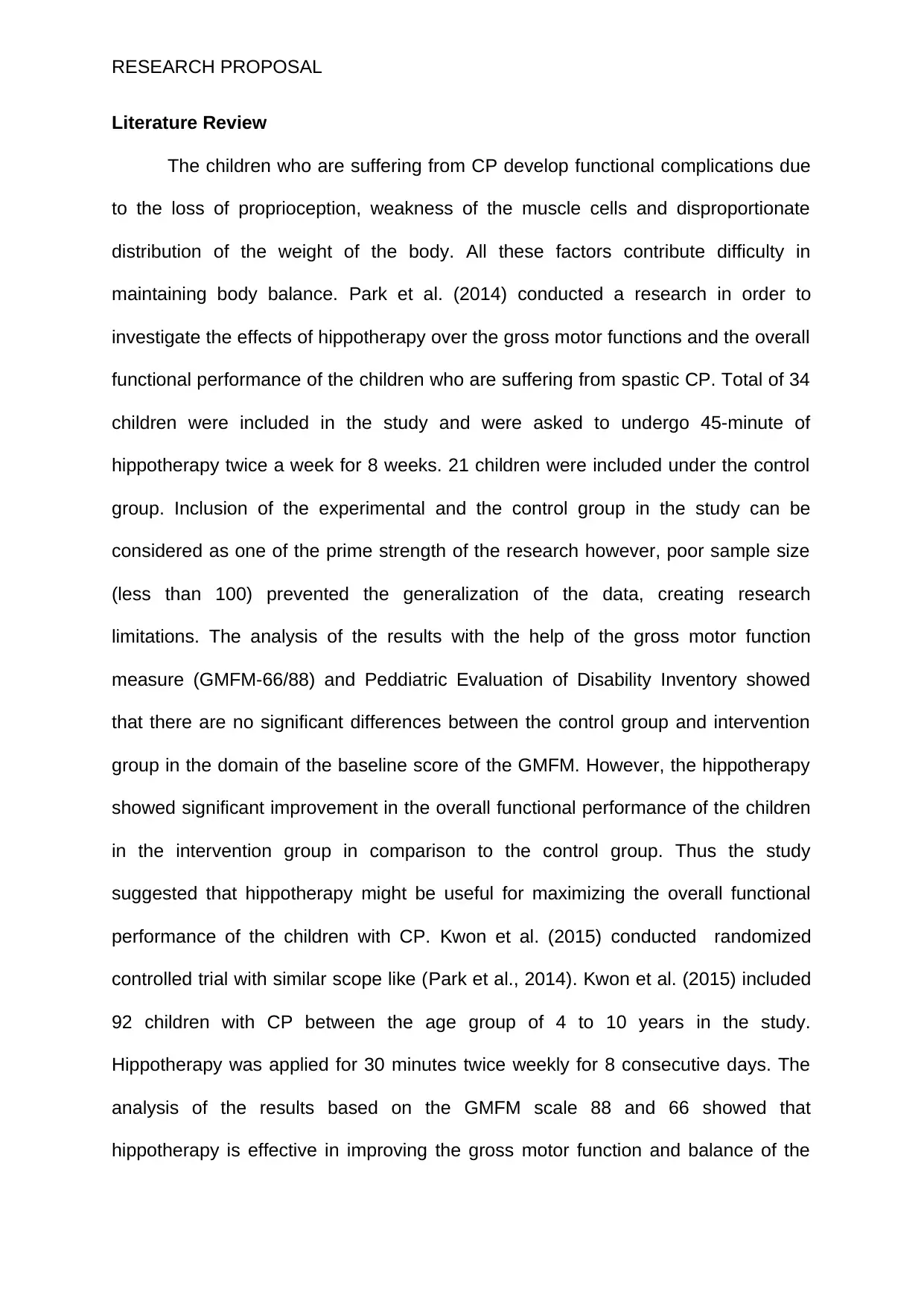
RESEARCH PROPOSAL
Literature Review
The children who are suffering from CP develop functional complications due
to the loss of proprioception, weakness of the muscle cells and disproportionate
distribution of the weight of the body. All these factors contribute difficulty in
maintaining body balance. Park et al. (2014) conducted a research in order to
investigate the effects of hippotherapy over the gross motor functions and the overall
functional performance of the children who are suffering from spastic CP. Total of 34
children were included in the study and were asked to undergo 45-minute of
hippotherapy twice a week for 8 weeks. 21 children were included under the control
group. Inclusion of the experimental and the control group in the study can be
considered as one of the prime strength of the research however, poor sample size
(less than 100) prevented the generalization of the data, creating research
limitations. The analysis of the results with the help of the gross motor function
measure (GMFM-66/88) and Peddiatric Evaluation of Disability Inventory showed
that there are no significant differences between the control group and intervention
group in the domain of the baseline score of the GMFM. However, the hippotherapy
showed significant improvement in the overall functional performance of the children
in the intervention group in comparison to the control group. Thus the study
suggested that hippotherapy might be useful for maximizing the overall functional
performance of the children with CP. Kwon et al. (2015) conducted randomized
controlled trial with similar scope like (Park et al., 2014). Kwon et al. (2015) included
92 children with CP between the age group of 4 to 10 years in the study.
Hippotherapy was applied for 30 minutes twice weekly for 8 consecutive days. The
analysis of the results based on the GMFM scale 88 and 66 showed that
hippotherapy is effective in improving the gross motor function and balance of the
Literature Review
The children who are suffering from CP develop functional complications due
to the loss of proprioception, weakness of the muscle cells and disproportionate
distribution of the weight of the body. All these factors contribute difficulty in
maintaining body balance. Park et al. (2014) conducted a research in order to
investigate the effects of hippotherapy over the gross motor functions and the overall
functional performance of the children who are suffering from spastic CP. Total of 34
children were included in the study and were asked to undergo 45-minute of
hippotherapy twice a week for 8 weeks. 21 children were included under the control
group. Inclusion of the experimental and the control group in the study can be
considered as one of the prime strength of the research however, poor sample size
(less than 100) prevented the generalization of the data, creating research
limitations. The analysis of the results with the help of the gross motor function
measure (GMFM-66/88) and Peddiatric Evaluation of Disability Inventory showed
that there are no significant differences between the control group and intervention
group in the domain of the baseline score of the GMFM. However, the hippotherapy
showed significant improvement in the overall functional performance of the children
in the intervention group in comparison to the control group. Thus the study
suggested that hippotherapy might be useful for maximizing the overall functional
performance of the children with CP. Kwon et al. (2015) conducted randomized
controlled trial with similar scope like (Park et al., 2014). Kwon et al. (2015) included
92 children with CP between the age group of 4 to 10 years in the study.
Hippotherapy was applied for 30 minutes twice weekly for 8 consecutive days. The
analysis of the results based on the GMFM scale 88 and 66 showed that
hippotherapy is effective in improving the gross motor function and balance of the
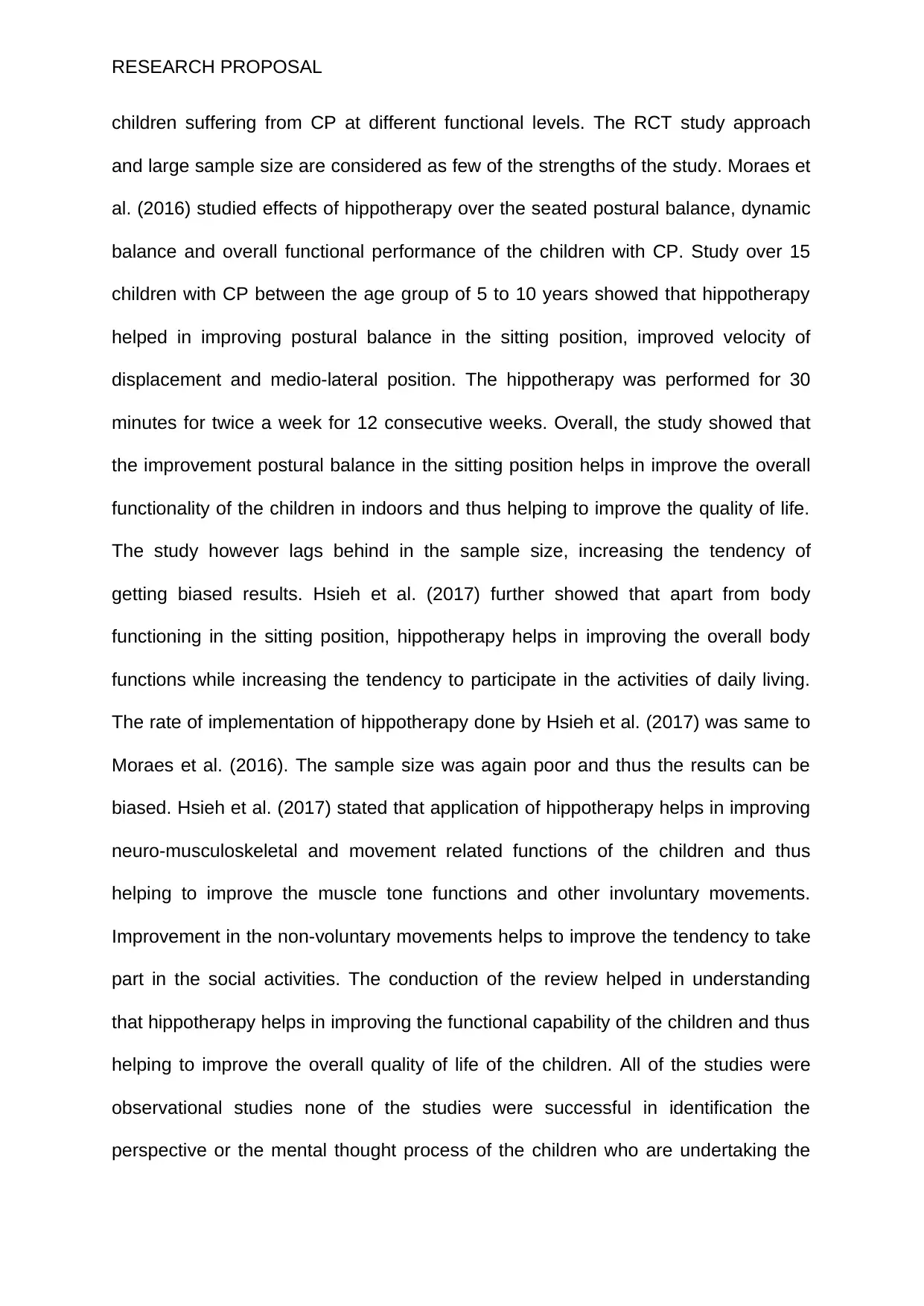
RESEARCH PROPOSAL
children suffering from CP at different functional levels. The RCT study approach
and large sample size are considered as few of the strengths of the study. Moraes et
al. (2016) studied effects of hippotherapy over the seated postural balance, dynamic
balance and overall functional performance of the children with CP. Study over 15
children with CP between the age group of 5 to 10 years showed that hippotherapy
helped in improving postural balance in the sitting position, improved velocity of
displacement and medio-lateral position. The hippotherapy was performed for 30
minutes for twice a week for 12 consecutive weeks. Overall, the study showed that
the improvement postural balance in the sitting position helps in improve the overall
functionality of the children in indoors and thus helping to improve the quality of life.
The study however lags behind in the sample size, increasing the tendency of
getting biased results. Hsieh et al. (2017) further showed that apart from body
functioning in the sitting position, hippotherapy helps in improving the overall body
functions while increasing the tendency to participate in the activities of daily living.
The rate of implementation of hippotherapy done by Hsieh et al. (2017) was same to
Moraes et al. (2016). The sample size was again poor and thus the results can be
biased. Hsieh et al. (2017) stated that application of hippotherapy helps in improving
neuro-musculoskeletal and movement related functions of the children and thus
helping to improve the muscle tone functions and other involuntary movements.
Improvement in the non-voluntary movements helps to improve the tendency to take
part in the social activities. The conduction of the review helped in understanding
that hippotherapy helps in improving the functional capability of the children and thus
helping to improve the overall quality of life of the children. All of the studies were
observational studies none of the studies were successful in identification the
perspective or the mental thought process of the children who are undertaking the
children suffering from CP at different functional levels. The RCT study approach
and large sample size are considered as few of the strengths of the study. Moraes et
al. (2016) studied effects of hippotherapy over the seated postural balance, dynamic
balance and overall functional performance of the children with CP. Study over 15
children with CP between the age group of 5 to 10 years showed that hippotherapy
helped in improving postural balance in the sitting position, improved velocity of
displacement and medio-lateral position. The hippotherapy was performed for 30
minutes for twice a week for 12 consecutive weeks. Overall, the study showed that
the improvement postural balance in the sitting position helps in improve the overall
functionality of the children in indoors and thus helping to improve the quality of life.
The study however lags behind in the sample size, increasing the tendency of
getting biased results. Hsieh et al. (2017) further showed that apart from body
functioning in the sitting position, hippotherapy helps in improving the overall body
functions while increasing the tendency to participate in the activities of daily living.
The rate of implementation of hippotherapy done by Hsieh et al. (2017) was same to
Moraes et al. (2016). The sample size was again poor and thus the results can be
biased. Hsieh et al. (2017) stated that application of hippotherapy helps in improving
neuro-musculoskeletal and movement related functions of the children and thus
helping to improve the muscle tone functions and other involuntary movements.
Improvement in the non-voluntary movements helps to improve the tendency to take
part in the social activities. The conduction of the review helped in understanding
that hippotherapy helps in improving the functional capability of the children and thus
helping to improve the overall quality of life of the children. All of the studies were
observational studies none of the studies were successful in identification the
perspective or the mental thought process of the children who are undertaking the
⊘ This is a preview!⊘
Do you want full access?
Subscribe today to unlock all pages.

Trusted by 1+ million students worldwide
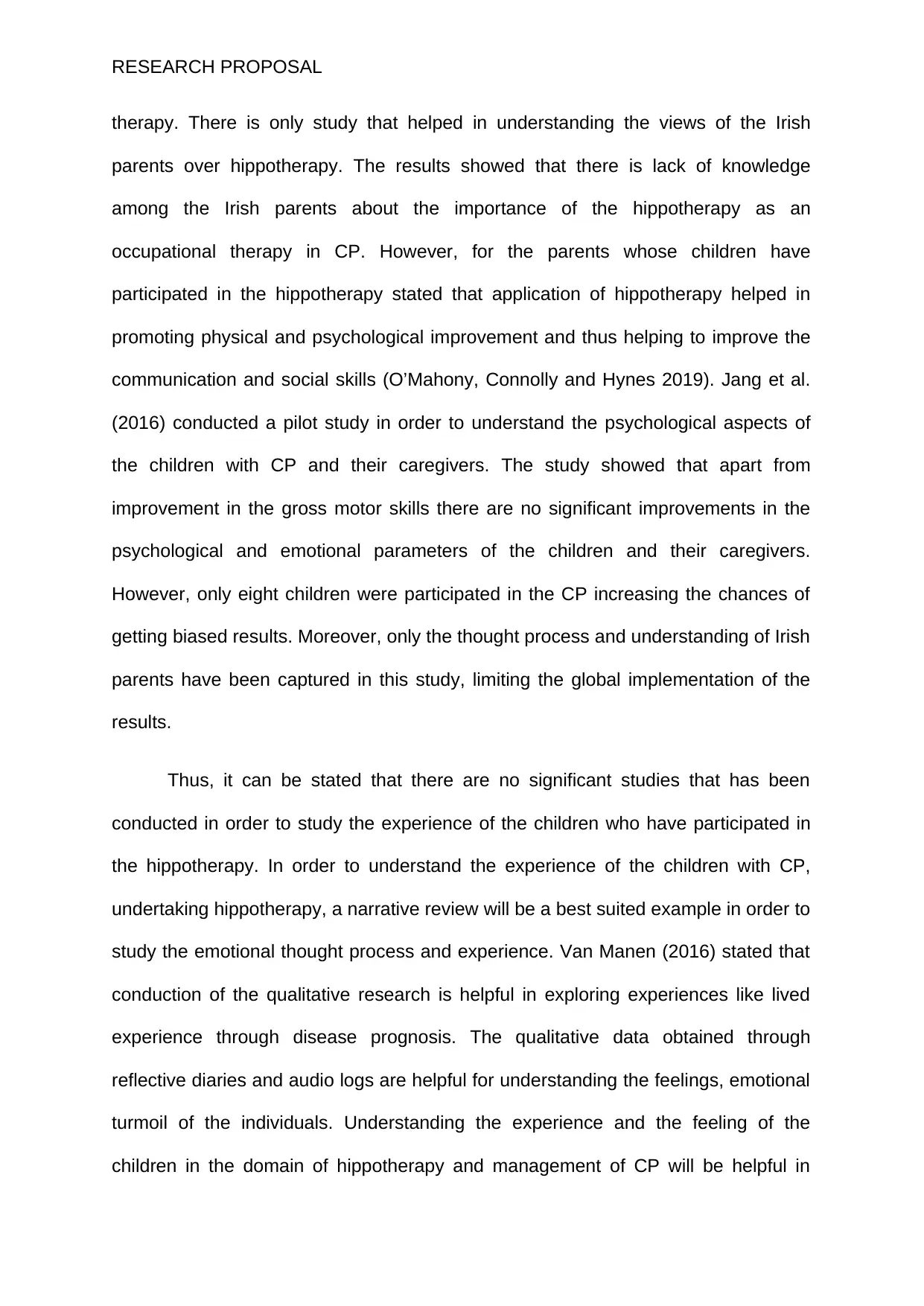
RESEARCH PROPOSAL
therapy. There is only study that helped in understanding the views of the Irish
parents over hippotherapy. The results showed that there is lack of knowledge
among the Irish parents about the importance of the hippotherapy as an
occupational therapy in CP. However, for the parents whose children have
participated in the hippotherapy stated that application of hippotherapy helped in
promoting physical and psychological improvement and thus helping to improve the
communication and social skills (O’Mahony, Connolly and Hynes 2019). Jang et al.
(2016) conducted a pilot study in order to understand the psychological aspects of
the children with CP and their caregivers. The study showed that apart from
improvement in the gross motor skills there are no significant improvements in the
psychological and emotional parameters of the children and their caregivers.
However, only eight children were participated in the CP increasing the chances of
getting biased results. Moreover, only the thought process and understanding of Irish
parents have been captured in this study, limiting the global implementation of the
results.
Thus, it can be stated that there are no significant studies that has been
conducted in order to study the experience of the children who have participated in
the hippotherapy. In order to understand the experience of the children with CP,
undertaking hippotherapy, a narrative review will be a best suited example in order to
study the emotional thought process and experience. Van Manen (2016) stated that
conduction of the qualitative research is helpful in exploring experiences like lived
experience through disease prognosis. The qualitative data obtained through
reflective diaries and audio logs are helpful for understanding the feelings, emotional
turmoil of the individuals. Understanding the experience and the feeling of the
children in the domain of hippotherapy and management of CP will be helpful in
therapy. There is only study that helped in understanding the views of the Irish
parents over hippotherapy. The results showed that there is lack of knowledge
among the Irish parents about the importance of the hippotherapy as an
occupational therapy in CP. However, for the parents whose children have
participated in the hippotherapy stated that application of hippotherapy helped in
promoting physical and psychological improvement and thus helping to improve the
communication and social skills (O’Mahony, Connolly and Hynes 2019). Jang et al.
(2016) conducted a pilot study in order to understand the psychological aspects of
the children with CP and their caregivers. The study showed that apart from
improvement in the gross motor skills there are no significant improvements in the
psychological and emotional parameters of the children and their caregivers.
However, only eight children were participated in the CP increasing the chances of
getting biased results. Moreover, only the thought process and understanding of Irish
parents have been captured in this study, limiting the global implementation of the
results.
Thus, it can be stated that there are no significant studies that has been
conducted in order to study the experience of the children who have participated in
the hippotherapy. In order to understand the experience of the children with CP,
undertaking hippotherapy, a narrative review will be a best suited example in order to
study the emotional thought process and experience. Van Manen (2016) stated that
conduction of the qualitative research is helpful in exploring experiences like lived
experience through disease prognosis. The qualitative data obtained through
reflective diaries and audio logs are helpful for understanding the feelings, emotional
turmoil of the individuals. Understanding the experience and the feeling of the
children in the domain of hippotherapy and management of CP will be helpful in
Paraphrase This Document
Need a fresh take? Get an instant paraphrase of this document with our AI Paraphraser
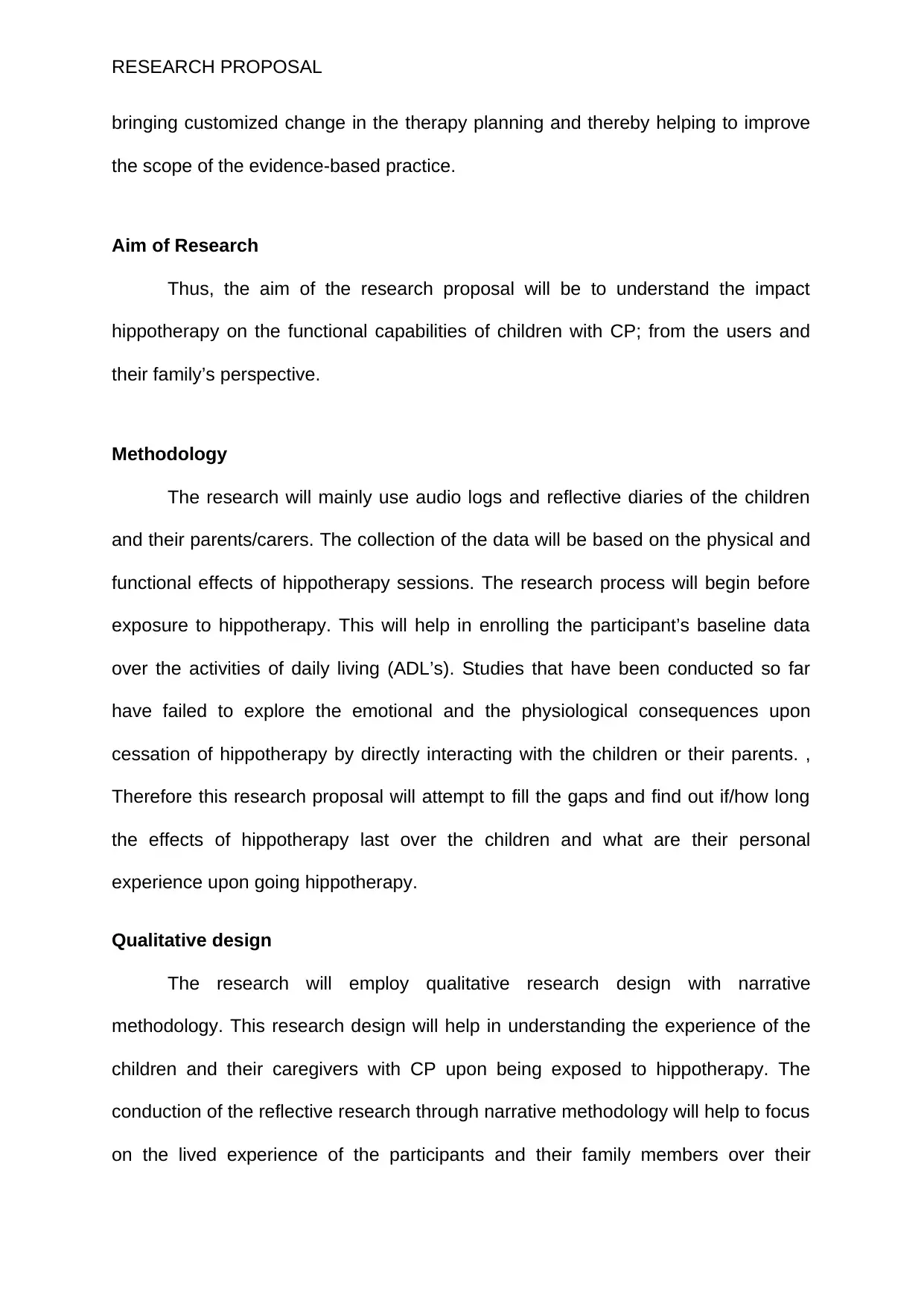
RESEARCH PROPOSAL
bringing customized change in the therapy planning and thereby helping to improve
the scope of the evidence-based practice.
Aim of Research
Thus, the aim of the research proposal will be to understand the impact
hippotherapy on the functional capabilities of children with CP; from the users and
their family’s perspective.
Methodology
The research will mainly use audio logs and reflective diaries of the children
and their parents/carers. The collection of the data will be based on the physical and
functional effects of hippotherapy sessions. The research process will begin before
exposure to hippotherapy. This will help in enrolling the participant’s baseline data
over the activities of daily living (ADL’s). Studies that have been conducted so far
have failed to explore the emotional and the physiological consequences upon
cessation of hippotherapy by directly interacting with the children or their parents. ,
Therefore this research proposal will attempt to fill the gaps and find out if/how long
the effects of hippotherapy last over the children and what are their personal
experience upon going hippotherapy.
Qualitative design
The research will employ qualitative research design with narrative
methodology. This research design will help in understanding the experience of the
children and their caregivers with CP upon being exposed to hippotherapy. The
conduction of the reflective research through narrative methodology will help to focus
on the lived experience of the participants and their family members over their
bringing customized change in the therapy planning and thereby helping to improve
the scope of the evidence-based practice.
Aim of Research
Thus, the aim of the research proposal will be to understand the impact
hippotherapy on the functional capabilities of children with CP; from the users and
their family’s perspective.
Methodology
The research will mainly use audio logs and reflective diaries of the children
and their parents/carers. The collection of the data will be based on the physical and
functional effects of hippotherapy sessions. The research process will begin before
exposure to hippotherapy. This will help in enrolling the participant’s baseline data
over the activities of daily living (ADL’s). Studies that have been conducted so far
have failed to explore the emotional and the physiological consequences upon
cessation of hippotherapy by directly interacting with the children or their parents. ,
Therefore this research proposal will attempt to fill the gaps and find out if/how long
the effects of hippotherapy last over the children and what are their personal
experience upon going hippotherapy.
Qualitative design
The research will employ qualitative research design with narrative
methodology. This research design will help in understanding the experience of the
children and their caregivers with CP upon being exposed to hippotherapy. The
conduction of the reflective research through narrative methodology will help to focus
on the lived experience of the participants and their family members over their
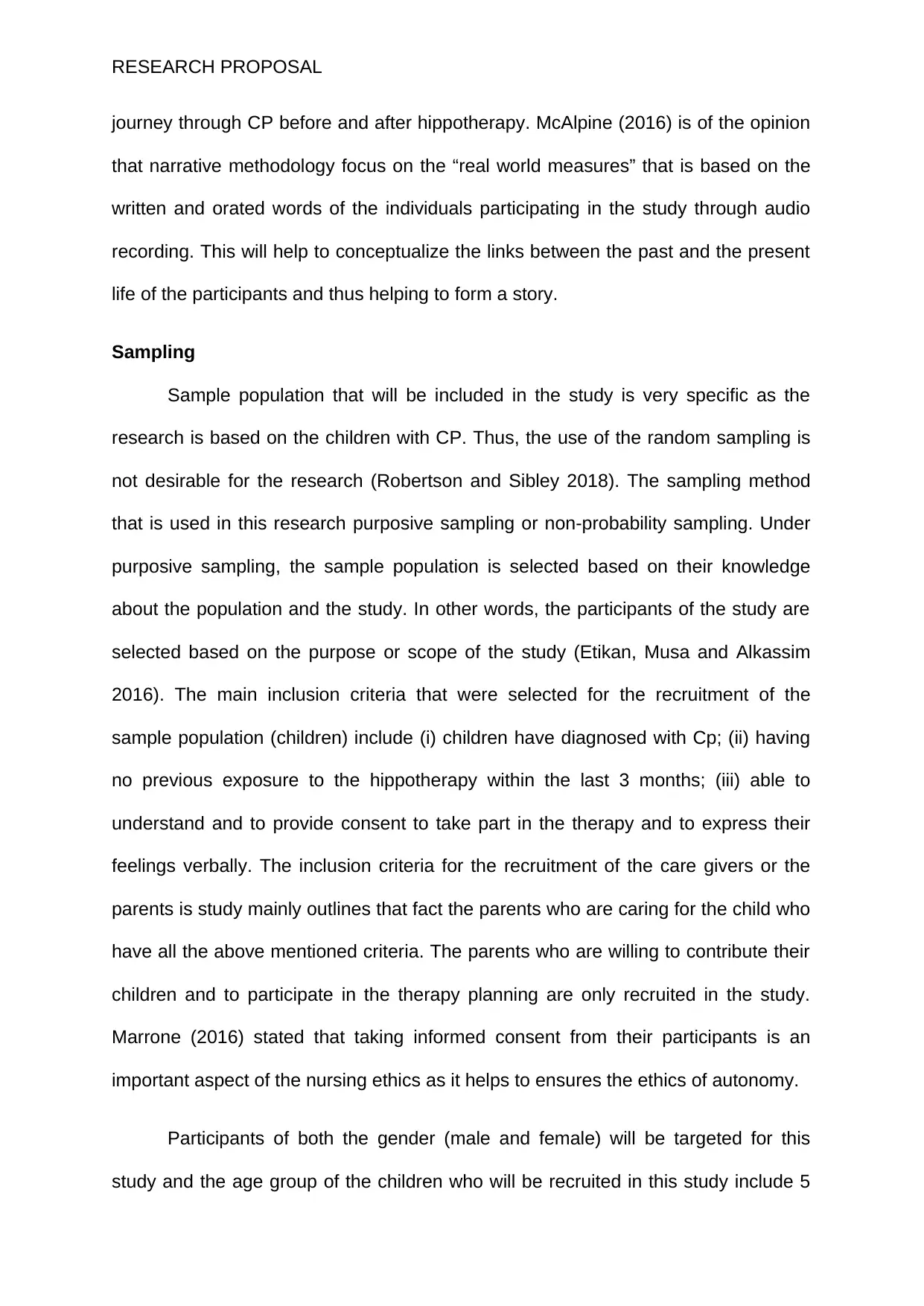
RESEARCH PROPOSAL
journey through CP before and after hippotherapy. McAlpine (2016) is of the opinion
that narrative methodology focus on the “real world measures” that is based on the
written and orated words of the individuals participating in the study through audio
recording. This will help to conceptualize the links between the past and the present
life of the participants and thus helping to form a story.
Sampling
Sample population that will be included in the study is very specific as the
research is based on the children with CP. Thus, the use of the random sampling is
not desirable for the research (Robertson and Sibley 2018). The sampling method
that is used in this research purposive sampling or non-probability sampling. Under
purposive sampling, the sample population is selected based on their knowledge
about the population and the study. In other words, the participants of the study are
selected based on the purpose or scope of the study (Etikan, Musa and Alkassim
2016). The main inclusion criteria that were selected for the recruitment of the
sample population (children) include (i) children have diagnosed with Cp; (ii) having
no previous exposure to the hippotherapy within the last 3 months; (iii) able to
understand and to provide consent to take part in the therapy and to express their
feelings verbally. The inclusion criteria for the recruitment of the care givers or the
parents is study mainly outlines that fact the parents who are caring for the child who
have all the above mentioned criteria. The parents who are willing to contribute their
children and to participate in the therapy planning are only recruited in the study.
Marrone (2016) stated that taking informed consent from their participants is an
important aspect of the nursing ethics as it helps to ensures the ethics of autonomy.
Participants of both the gender (male and female) will be targeted for this
study and the age group of the children who will be recruited in this study include 5
journey through CP before and after hippotherapy. McAlpine (2016) is of the opinion
that narrative methodology focus on the “real world measures” that is based on the
written and orated words of the individuals participating in the study through audio
recording. This will help to conceptualize the links between the past and the present
life of the participants and thus helping to form a story.
Sampling
Sample population that will be included in the study is very specific as the
research is based on the children with CP. Thus, the use of the random sampling is
not desirable for the research (Robertson and Sibley 2018). The sampling method
that is used in this research purposive sampling or non-probability sampling. Under
purposive sampling, the sample population is selected based on their knowledge
about the population and the study. In other words, the participants of the study are
selected based on the purpose or scope of the study (Etikan, Musa and Alkassim
2016). The main inclusion criteria that were selected for the recruitment of the
sample population (children) include (i) children have diagnosed with Cp; (ii) having
no previous exposure to the hippotherapy within the last 3 months; (iii) able to
understand and to provide consent to take part in the therapy and to express their
feelings verbally. The inclusion criteria for the recruitment of the care givers or the
parents is study mainly outlines that fact the parents who are caring for the child who
have all the above mentioned criteria. The parents who are willing to contribute their
children and to participate in the therapy planning are only recruited in the study.
Marrone (2016) stated that taking informed consent from their participants is an
important aspect of the nursing ethics as it helps to ensures the ethics of autonomy.
Participants of both the gender (male and female) will be targeted for this
study and the age group of the children who will be recruited in this study include 5
⊘ This is a preview!⊘
Do you want full access?
Subscribe today to unlock all pages.

Trusted by 1+ million students worldwide
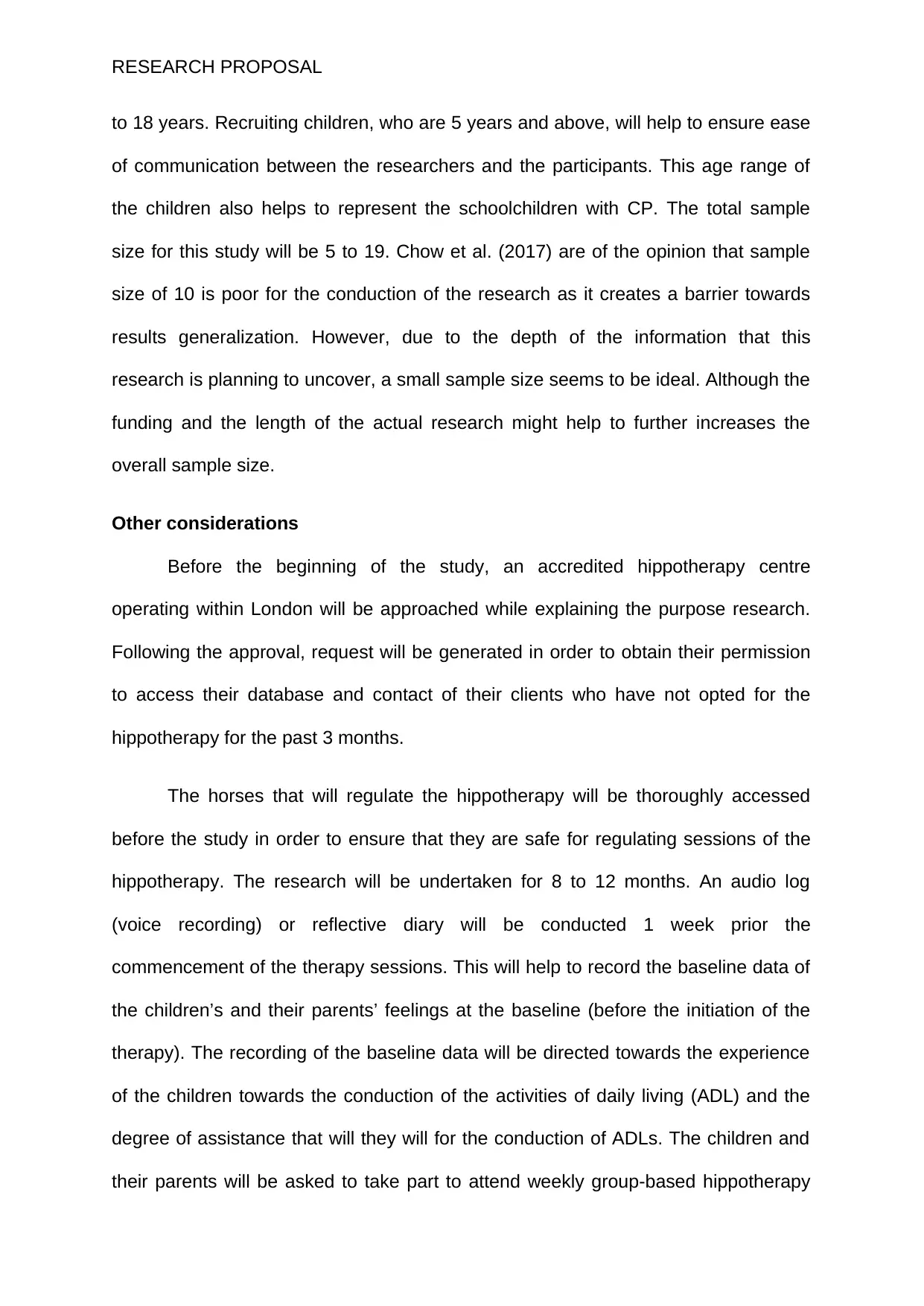
RESEARCH PROPOSAL
to 18 years. Recruiting children, who are 5 years and above, will help to ensure ease
of communication between the researchers and the participants. This age range of
the children also helps to represent the schoolchildren with CP. The total sample
size for this study will be 5 to 19. Chow et al. (2017) are of the opinion that sample
size of 10 is poor for the conduction of the research as it creates a barrier towards
results generalization. However, due to the depth of the information that this
research is planning to uncover, a small sample size seems to be ideal. Although the
funding and the length of the actual research might help to further increases the
overall sample size.
Other considerations
Before the beginning of the study, an accredited hippotherapy centre
operating within London will be approached while explaining the purpose research.
Following the approval, request will be generated in order to obtain their permission
to access their database and contact of their clients who have not opted for the
hippotherapy for the past 3 months.
The horses that will regulate the hippotherapy will be thoroughly accessed
before the study in order to ensure that they are safe for regulating sessions of the
hippotherapy. The research will be undertaken for 8 to 12 months. An audio log
(voice recording) or reflective diary will be conducted 1 week prior the
commencement of the therapy sessions. This will help to record the baseline data of
the children’s and their parents’ feelings at the baseline (before the initiation of the
therapy). The recording of the baseline data will be directed towards the experience
of the children towards the conduction of the activities of daily living (ADL) and the
degree of assistance that will they will for the conduction of ADLs. The children and
their parents will be asked to take part to attend weekly group-based hippotherapy
to 18 years. Recruiting children, who are 5 years and above, will help to ensure ease
of communication between the researchers and the participants. This age range of
the children also helps to represent the schoolchildren with CP. The total sample
size for this study will be 5 to 19. Chow et al. (2017) are of the opinion that sample
size of 10 is poor for the conduction of the research as it creates a barrier towards
results generalization. However, due to the depth of the information that this
research is planning to uncover, a small sample size seems to be ideal. Although the
funding and the length of the actual research might help to further increases the
overall sample size.
Other considerations
Before the beginning of the study, an accredited hippotherapy centre
operating within London will be approached while explaining the purpose research.
Following the approval, request will be generated in order to obtain their permission
to access their database and contact of their clients who have not opted for the
hippotherapy for the past 3 months.
The horses that will regulate the hippotherapy will be thoroughly accessed
before the study in order to ensure that they are safe for regulating sessions of the
hippotherapy. The research will be undertaken for 8 to 12 months. An audio log
(voice recording) or reflective diary will be conducted 1 week prior the
commencement of the therapy sessions. This will help to record the baseline data of
the children’s and their parents’ feelings at the baseline (before the initiation of the
therapy). The recording of the baseline data will be directed towards the experience
of the children towards the conduction of the activities of daily living (ADL) and the
degree of assistance that will they will for the conduction of ADLs. The children and
their parents will be asked to take part to attend weekly group-based hippotherapy
Paraphrase This Document
Need a fresh take? Get an instant paraphrase of this document with our AI Paraphraser
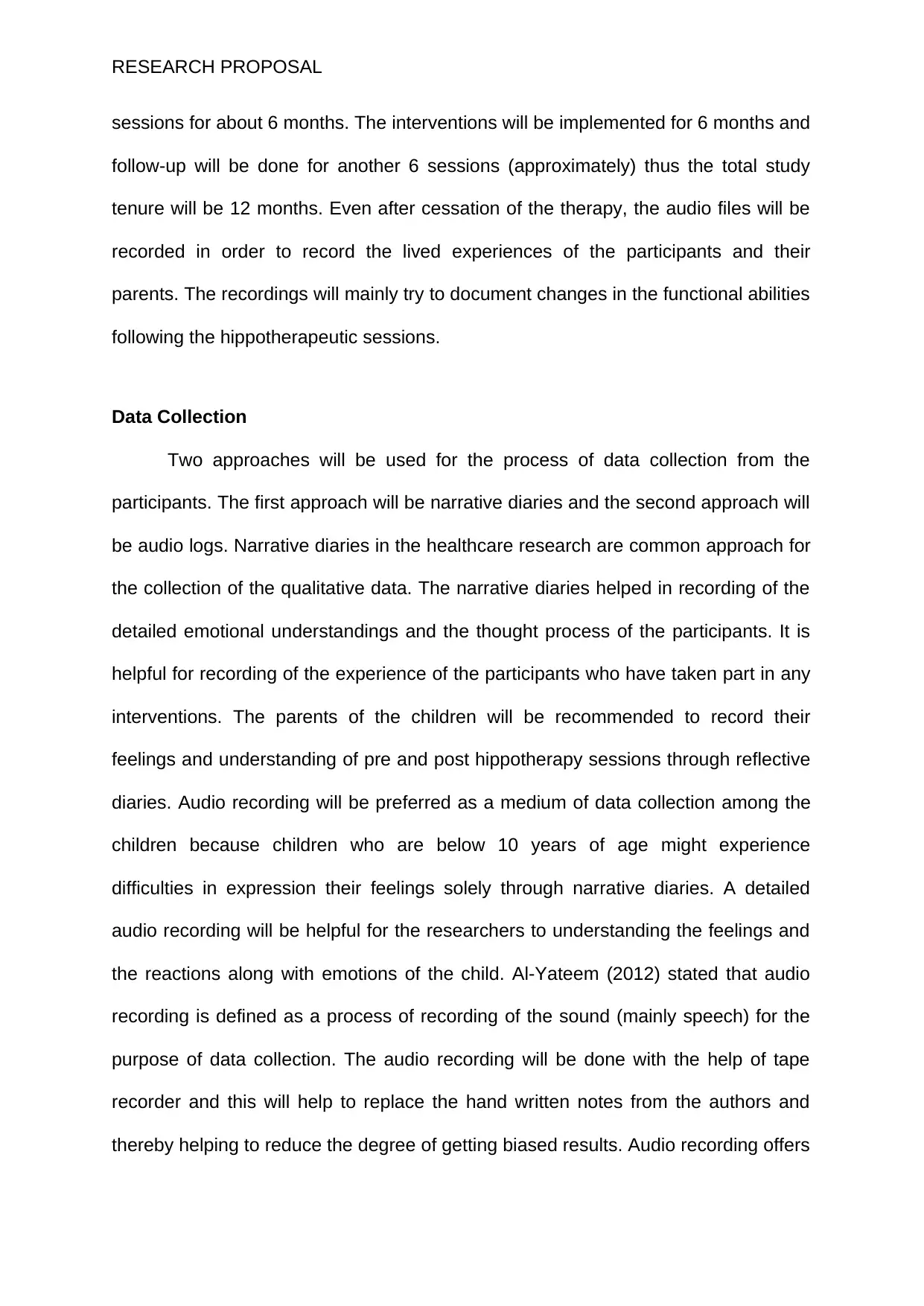
RESEARCH PROPOSAL
sessions for about 6 months. The interventions will be implemented for 6 months and
follow-up will be done for another 6 sessions (approximately) thus the total study
tenure will be 12 months. Even after cessation of the therapy, the audio files will be
recorded in order to record the lived experiences of the participants and their
parents. The recordings will mainly try to document changes in the functional abilities
following the hippotherapeutic sessions.
Data Collection
Two approaches will be used for the process of data collection from the
participants. The first approach will be narrative diaries and the second approach will
be audio logs. Narrative diaries in the healthcare research are common approach for
the collection of the qualitative data. The narrative diaries helped in recording of the
detailed emotional understandings and the thought process of the participants. It is
helpful for recording of the experience of the participants who have taken part in any
interventions. The parents of the children will be recommended to record their
feelings and understanding of pre and post hippotherapy sessions through reflective
diaries. Audio recording will be preferred as a medium of data collection among the
children because children who are below 10 years of age might experience
difficulties in expression their feelings solely through narrative diaries. A detailed
audio recording will be helpful for the researchers to understanding the feelings and
the reactions along with emotions of the child. Al-Yateem (2012) stated that audio
recording is defined as a process of recording of the sound (mainly speech) for the
purpose of data collection. The audio recording will be done with the help of tape
recorder and this will help to replace the hand written notes from the authors and
thereby helping to reduce the degree of getting biased results. Audio recording offers
sessions for about 6 months. The interventions will be implemented for 6 months and
follow-up will be done for another 6 sessions (approximately) thus the total study
tenure will be 12 months. Even after cessation of the therapy, the audio files will be
recorded in order to record the lived experiences of the participants and their
parents. The recordings will mainly try to document changes in the functional abilities
following the hippotherapeutic sessions.
Data Collection
Two approaches will be used for the process of data collection from the
participants. The first approach will be narrative diaries and the second approach will
be audio logs. Narrative diaries in the healthcare research are common approach for
the collection of the qualitative data. The narrative diaries helped in recording of the
detailed emotional understandings and the thought process of the participants. It is
helpful for recording of the experience of the participants who have taken part in any
interventions. The parents of the children will be recommended to record their
feelings and understanding of pre and post hippotherapy sessions through reflective
diaries. Audio recording will be preferred as a medium of data collection among the
children because children who are below 10 years of age might experience
difficulties in expression their feelings solely through narrative diaries. A detailed
audio recording will be helpful for the researchers to understanding the feelings and
the reactions along with emotions of the child. Al-Yateem (2012) stated that audio
recording is defined as a process of recording of the sound (mainly speech) for the
purpose of data collection. The audio recording will be done with the help of tape
recorder and this will help to replace the hand written notes from the authors and
thereby helping to reduce the degree of getting biased results. Audio recording offers
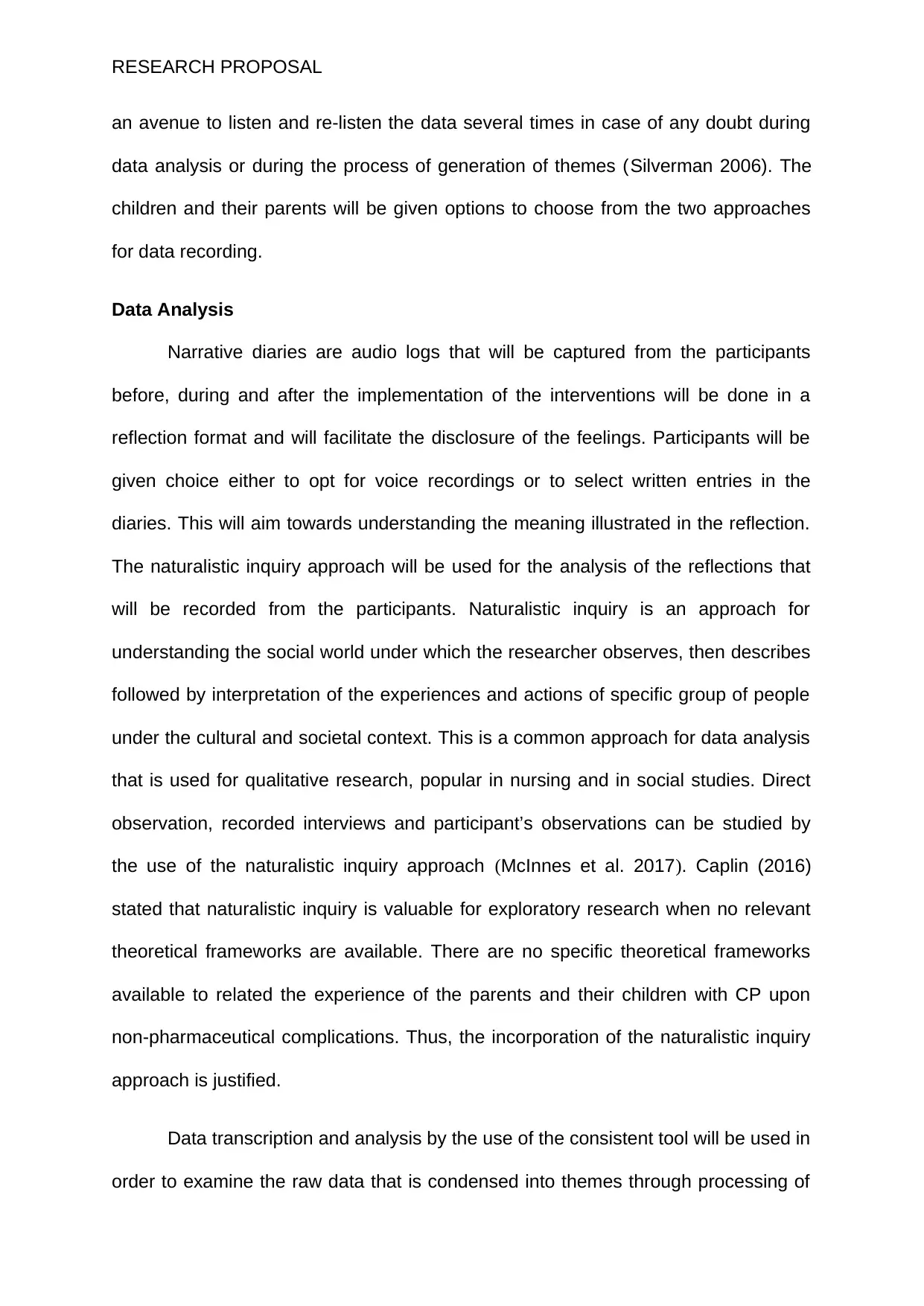
RESEARCH PROPOSAL
an avenue to listen and re-listen the data several times in case of any doubt during
data analysis or during the process of generation of themes (Silverman 2006). The
children and their parents will be given options to choose from the two approaches
for data recording.
Data Analysis
Narrative diaries are audio logs that will be captured from the participants
before, during and after the implementation of the interventions will be done in a
reflection format and will facilitate the disclosure of the feelings. Participants will be
given choice either to opt for voice recordings or to select written entries in the
diaries. This will aim towards understanding the meaning illustrated in the reflection.
The naturalistic inquiry approach will be used for the analysis of the reflections that
will be recorded from the participants. Naturalistic inquiry is an approach for
understanding the social world under which the researcher observes, then describes
followed by interpretation of the experiences and actions of specific group of people
under the cultural and societal context. This is a common approach for data analysis
that is used for qualitative research, popular in nursing and in social studies. Direct
observation, recorded interviews and participant’s observations can be studied by
the use of the naturalistic inquiry approach (McInnes et al. 2017). Caplin (2016)
stated that naturalistic inquiry is valuable for exploratory research when no relevant
theoretical frameworks are available. There are no specific theoretical frameworks
available to related the experience of the parents and their children with CP upon
non-pharmaceutical complications. Thus, the incorporation of the naturalistic inquiry
approach is justified.
Data transcription and analysis by the use of the consistent tool will be used in
order to examine the raw data that is condensed into themes through processing of
an avenue to listen and re-listen the data several times in case of any doubt during
data analysis or during the process of generation of themes (Silverman 2006). The
children and their parents will be given options to choose from the two approaches
for data recording.
Data Analysis
Narrative diaries are audio logs that will be captured from the participants
before, during and after the implementation of the interventions will be done in a
reflection format and will facilitate the disclosure of the feelings. Participants will be
given choice either to opt for voice recordings or to select written entries in the
diaries. This will aim towards understanding the meaning illustrated in the reflection.
The naturalistic inquiry approach will be used for the analysis of the reflections that
will be recorded from the participants. Naturalistic inquiry is an approach for
understanding the social world under which the researcher observes, then describes
followed by interpretation of the experiences and actions of specific group of people
under the cultural and societal context. This is a common approach for data analysis
that is used for qualitative research, popular in nursing and in social studies. Direct
observation, recorded interviews and participant’s observations can be studied by
the use of the naturalistic inquiry approach (McInnes et al. 2017). Caplin (2016)
stated that naturalistic inquiry is valuable for exploratory research when no relevant
theoretical frameworks are available. There are no specific theoretical frameworks
available to related the experience of the parents and their children with CP upon
non-pharmaceutical complications. Thus, the incorporation of the naturalistic inquiry
approach is justified.
Data transcription and analysis by the use of the consistent tool will be used in
order to examine the raw data that is condensed into themes through processing of
⊘ This is a preview!⊘
Do you want full access?
Subscribe today to unlock all pages.

Trusted by 1+ million students worldwide
1 out of 18
Your All-in-One AI-Powered Toolkit for Academic Success.
+13062052269
info@desklib.com
Available 24*7 on WhatsApp / Email
![[object Object]](/_next/static/media/star-bottom.7253800d.svg)
Unlock your academic potential
Copyright © 2020–2025 A2Z Services. All Rights Reserved. Developed and managed by ZUCOL.
